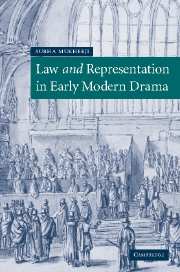Book contents
- Frontmatter
- Contents
- List of illustrations
- List of maps
- Acknowledgements
- Glossary
- A note on the text
- List of abbreviations
- Introduction
- 1 ‘Of rings, and things, and fine array’: marriage law, evidence and uncertainty
- 2 ‘Unmanly indignities’: adultery, evidence and judgement in Heywood's A Woman Killed With Kindness
- 3 Evidence and representation on ‘the theatre of God's judgements’: A Warning for Fair Women
- 4 ‘Painted devils’: image-making and evidence in The White Devil
- 5 Locations of law: spaces, people, play
- 6 ‘When women go to Law, the Devil is full of Business’: women, law and dramatic realism
- Epilogue: The Hydra head, the labyrinth and the waxen nose: discursive metaphors for law
- Appendix
- Bibliography
- Index
Epilogue: The Hydra head, the labyrinth and the waxen nose: discursive metaphors for law
Published online by Cambridge University Press: 18 December 2009
- Frontmatter
- Contents
- List of illustrations
- List of maps
- Acknowledgements
- Glossary
- A note on the text
- List of abbreviations
- Introduction
- 1 ‘Of rings, and things, and fine array’: marriage law, evidence and uncertainty
- 2 ‘Unmanly indignities’: adultery, evidence and judgement in Heywood's A Woman Killed With Kindness
- 3 Evidence and representation on ‘the theatre of God's judgements’: A Warning for Fair Women
- 4 ‘Painted devils’: image-making and evidence in The White Devil
- 5 Locations of law: spaces, people, play
- 6 ‘When women go to Law, the Devil is full of Business’: women, law and dramatic realism
- Epilogue: The Hydra head, the labyrinth and the waxen nose: discursive metaphors for law
- Appendix
- Bibliography
- Index
Summary
Having secured a clandestine marriage with Francis, impersonating Constantia, Throat the ‘man of law’ in Barry's Ram Alley, brags that
The knot is knit, which not the law itself,
With all its Hydra-heads and strongest nerves
Is able to disjoin …
(1236–8)The ‘Hydra-head’ evokes a sense of bewildering, even dangerous, multiplicity which brings us full circle and takes us back to the plurality of marriage laws discussed in Chapter 1, which Swinburne tries to reduce and fix in his treatises. As Justice Tutchin says, ‘the laws,/They are so many that men do stand in awe/Of none at all’ (RA, 1864–6). What he refers to, in a comic key, are the multiple devices at the disposal of law and its users; Swinburne's is a more troubled engagement with the multiple signification of laws that gives rise to the potential multiplicity in their application. Richard Braithwaite, a trenchant critic and satirist of law, is picking up both on the sense of indefinite proliferation and that of manipulability when he writes, around 1630, about the perversity of ‘suits of law’: ‘censuring time and substance in frivolous delays, and multiplicity of orders, which like Hydra's heads, by lopping off or annulling one, gives way to decreeing another’.
In both Ram Alley and Swinburne's Spousals, the immediate subject is marriage law. As we have seen, the confusion of laws and opinions on the eve of the Reformation created a scenario where any number of the associated formalities coexisting in a reasonable mixture was likely to endow the event of a marriage with a degree of finality at the same time as it left the contract liable to question.
- Type
- Chapter
- Information
- Law and Representation in Early Modern Drama , pp. 233 - 248Publisher: Cambridge University PressPrint publication year: 2006



